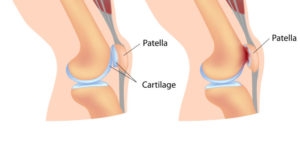If you are feeling a dull, aching pain in the front of your knee, behind your kneecap, a pain that can get worse when you go up or downstairs. It can flare up after you have been sitting in one position for a long time. Is your knee painful and stiff when you stand up after watching a movie or after a long trip in a car or plane? You could be suffering from Chondromalacia. Chondromalacia also can make your knee joint “catch” meaning you suddenly have trouble moving it past a certain point, or “give way” (buckle unexpectedly). These symptoms tend to occur when you bend your knee repeatedly, especially when you go downstairs. In some cases, the painful knee also can appear puffy or swollen. Chondromalacia can cause a creaky sound or grinding sensation when you move your knee. Let’s talk a bit about this condition, and how physical therapy will help you.
“The joints in your body are cushioned with a type of tissue called articular cartilage. This tough, rubbery tissue covers the ends of bones inside a joint. As the joint moves, the cartilage helps to cushion the bones and allows them to glide smoothly against one another. Sometimes, the cartilage inside a joint softens and breaks down. This condition is called chondromalacia. The cartilage loses its ability to protect the ends of the bones as the joint moves. The ends of the bones can rub together, causing pain.” according to Harvard Medical School.
Chondromalacia can affect any joint, but the most common location is inside the knee. It usually begins as a small area of softened cartilage behind the kneecap (patella) that can be painful. Eventually, more of the cartilage softens, and the softened cartilage can crack or shred into a mass of fibers. In severe cases, the damaged cartilage can wear away completely, down to the undersurface of the kneecap. If this happens, the exposed kneecap’s bony surface can grind painfully against other knee bones. Also, bits of cartilage can float inside the joint, further irritating the cells that line the joint. In response, these cells produce fluid inside the joint (called a joint effusion).
At CardioFlex Therapy, our physical therapists are professionally trained to help patients that are suffering from Chondromalacia, and can be especially helpful to safely guide patients through these treatments: using knee tape, a brace or a special patellar-tracking sleeve to keep your kneecap aligned properly, starting an exercise program to strengthen the muscles around your knee. We recommend avoiding high-impact exercises, avoiding all kneeling and squatting.
For more info visit: www.cardioflextherapy.com

